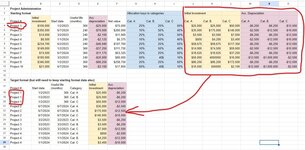I have some project admin data in the format of the first table. This is how I receive the data and it will keep on being received like this. Pease note that the number of allocation categories can sometimes change from A,B,C, to A,B,C,D, for example and so the number of categories may change when updating the data.
I want to transform the layout of the data easily to the target format shown at the bottom. Have tried pivots & transpose options but I cannot figure it out to get exactly how I want it.
Any tips welcome!
I want to transform the layout of the data easily to the target format shown at the bottom. Have tried pivots & transpose options but I cannot figure it out to get exactly how I want it.
Any tips welcome!






